Ouch – we had some monster neuroanatomy learning outcomes this week. From an anatomy perspective we want students to be aware of the major motor and sensory tracts of the spinal cord, what type of information they carry, where they run (and where they cross over from one side to the other), and what would happen if the spinal cord or brainstem was damaged on just one side in terms of sensory info coming into the brain and muscle control. (It’s pretty easy to work out what would happen if the spinal cord or brainstem is completely severed).
I’ve included a bunch of images, but excuse my scribbles, lack of legends and minimal labels. Some of this is intentional, and some of it suggests I don’t have enough time to do this as completely as I would like (I tried to write this when I taught it last year and have had it on my to do list for 12 months!) The images below are of a spinal cord in transverse section with some of the spinal tracts indicated by coloured blobs, and of the brain, midbrain and spinal cord cut in coronal section with the paths of neurones indicated. Yes, really, that’s the brain at the top of the diagram. The thick grey is the grey matter of the cerebral (and cerebellar) cortex.
We started with the spinal cord. By now you guys have a pretty good idea of the structure of the spinal cord, and we ran through the white (myelinated neurone axons running up and down the spinal cord) and grey (cell bodies, synapses) matter, the ventral horns (motor neurones go out) and dorsal horns (sensory neurones come in) and talked briefly about the terms “commissure” and “decussation“, because the concept of neurones crossing from one side of the body to the other is important.
Tracts within the spinal cord are bundles of neurones running together, usually with a common function and going to or coming from similar places. A fascicle does the same thing. Some areas of the spinal cord are described as columns, such as the dorsal column of the spinal cord’s white matter, in which tracts run bunched together.
Some major tracts to be concerned with are the corticospinal tracts (ok, there are lateral and anterior corticospinal tracts so that’s two on either side), spinothalamic tracts, dorsal column tracts, and maybe spinocerebellar tracts.
Corticospinal tracts carry motor neurones (and upper motor neurones at that). Upper motor neurones start in the cortex of the brain, namely the motor cortex (or precentral cortex), run through the white matter of the brain to the brainstem, cross over to the other side of the body (decussate) in the pyramidal decussation of the medulla, and then carry on down the spinal cord in the lateral corticospinal tract. At the appropriate level they synapse with a new motor neurone (this would be a lower motor neurone) in the ventral horn of the spinal cord, which carries the action potential out along a spinal nerve and peripheral nerves to the target muscle (and the muscle contracts). The muscle that contracts is on the opposite side of the body to the side of the brain that started this, in the motor cortex.
Well, this happens for around 90% of upper motor neurones. The rest run down the same side of the body as the side of the brain that they started from, in the anterior corticospinal tract. They tend to control muscles of the body wall.
If the spinal cord is damaged on only one side, muscles on the same side as the injury (ipsilateral) will be affected because they decussated up in the medulla. (Damage to upper motor neurones tends to give muscle weakness, increased muscle tone and changes in reflexes.) Theoretically if the brainstem was damaged superior to the pyramidal decussation, effects on muscles on the opposite side to the lesion (contralateral) would be seen.
Dorsal columns and spinothalamic tracts carry sensory neurones up the spinal cord to the thalamus (which filters sensory information before relaying appropriate stuff to the somatosensory cortex).
The dorsal columns contain neurones conveying fine touch, vibration, two-point discrimination and proprioception. Peripheral neurones pass into the dorsal horn of the grey matter, pass into the dorsal column (without synapsing) and stay on the same side of the spinal cord, running superiorly to the brainstem, where they synapse with a second order neurone. This second order neurone crosses to the other side of the body and ascends to the thalamus.
Spinothalamic tracts convey neurones of pain, temperature and crude touch. In these cases peripheral neurones enter the dorsal horn of the grey matter, and may ascend on the edge of the dorsal horn for a couple of spinal segments. There they synapse with a second neurone, which crosses to the other side of the spinal cord and ascends within the spinothalamic tracts through the brainstem to the thalamus.
If we consider injury to the brainstem again, in the case of sensory information the patient would lose senses of pain, touch and proprioception on the opposite side (contralateral) of the body to the lesion (because all of the sensory neurones have crossed to the other side by this level).
If we consider injury to the spinal cord, the patient would lose senses of pain and temperature on the opposite side of the body to the lesion (those neurones crossed sides already) but would lose senses of touch and proprioception on the same side as the lesion (those neurones will not cross sides until they get to the brainstem).
Weird, huh? Have a read about Brown-Sequard syndrome.
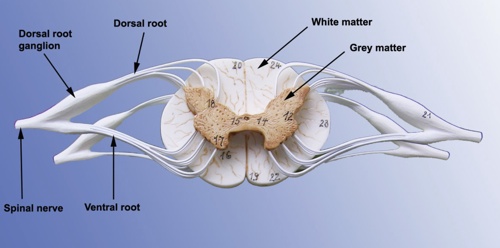
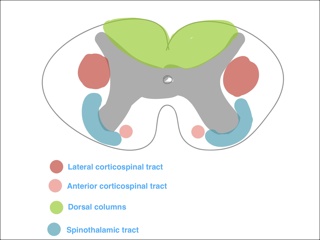
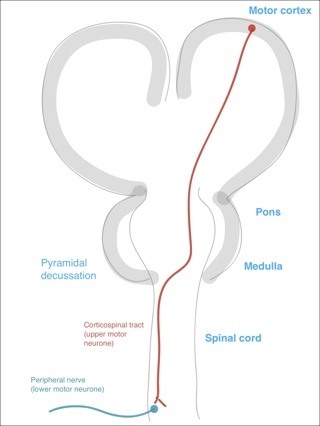
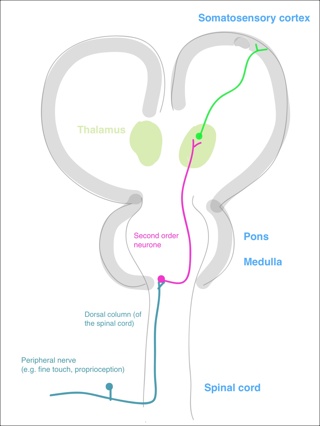
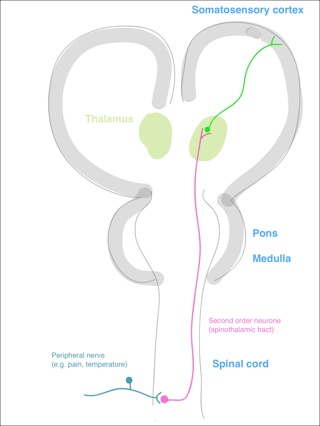
Comments
4 responses to “Week 222: spinal tracts”
Is it OK to use your images for teaching? thank you for considering!
Sure, although they’re just scribbles from my iPad. I’m sure you could create something as effective!
Excellent report- thank you! May I include the first image (spinal cord cross section) in my dissertation on CNS regeneration?
Sure, please do.